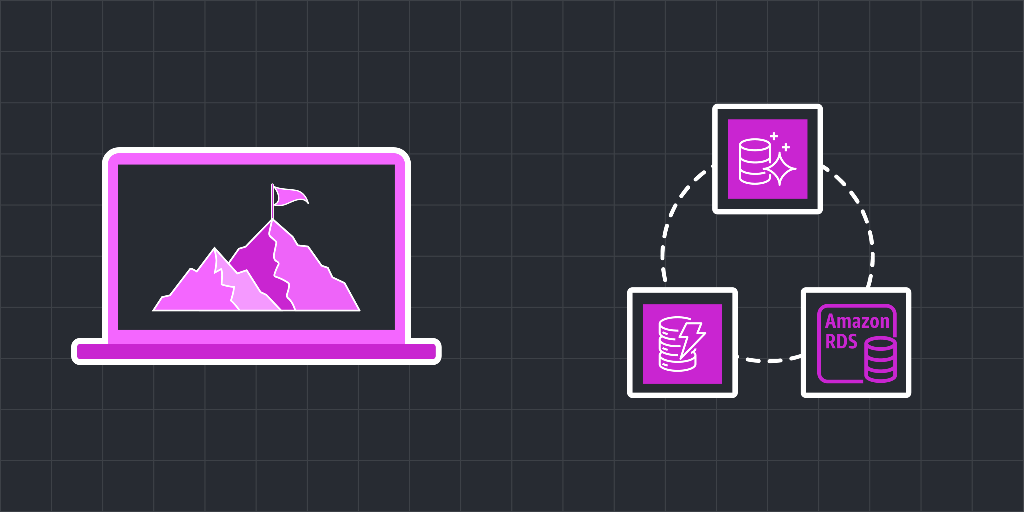

CLOUD LABS
Understanding AWS Database Options—From Zero to Hero
In this Cloud Lab, you’ll learn to integrate DynamoDB, RDS, and Aurora into a live website running on an EC2 instance.
beginner
Certificate of Completion
Learning Objectives


Amazon Web Services (AWS) provides database services that allow you to efficiently store, manage, and retrieve data. This Cloud Lab focuses on equipping you with the skills needed to work with various AWS database solutions, including Amazon RDS, Amazon Aurora, and DynamoDB. You’ll learn how to create, configure, and integrate these databases with applications, enabling you to build scalable and reliable data-driven systems.
Firstly, you’ll create an EC2 instance and set it up to host a social media application. Following this, you’ll work on integrating the application with various database services like RDS, Aurora, and DynamoDB. This hands-on experience will provide valuable insights into the seamless interaction between your application and different database systems.
After completing this Cloud Lab, you’ll be well-equipped to leverage your knowledge of database connections in real-world scenarios. This skill set can significantly advance your career, allowing you to take on projects that involve deploying web applications and services on Amazon EC2, thus enhancing your proficiency in cloud-based solutions.
The following is the high-level architecture diagram of the final infrastructure that you will build in this Cloud Lab:

Before you start...
Try these optional labs before starting this lab.
Relevant Courses
Use the following content to review prerequisites or explore specific concepts in detail.
Frequently Asked Questions
How many types of databases are in AWS?
AWS offers several types of databases, which can be categorized into:
- Relational databases, such as Amazon RDS and Amazon Aurora
- NoSQL databases, such as Amazon DynamoDB, DocumentDB, and Amazon Keyspaces
- In-memory databases, like ElastiCache (Redis/Memcached), MemoryDB for Redis
- Graph databases, such as Amazon Neptune
- Time series database, such as Timestream
- Data warehousing, using Amazon Redshift
What is the best database for AWS?
The best database depends on your specific needs:
- Amazon RDS or Aurora are excellent relational database options for traditional applications needing strong consistency.
- For high-speed, low-latency requirements, Amazon DynamoDB (NoSQL) works well.
- If your application needs caching, Amazon ElastiCache is ideal.
- For analytics and big data workloads, Amazon Redshift is the go-to choice.
- Choosing the right database depends on scalability, data structure, and access patterns.
What is the difference between RDS and DynamoDB?
Amazon RDS is a relational database service supporting engines like MySQL, PostgreSQL, and SQL Server. It is ideal for structured data and complex queries. DynamoDB is a NoSQL database designed for key-value and document storage. It offers high scalability and low-latency performance for unstructured or semi-structured data. RDS is better for transactional workloads, while DynamoDB excels in high-speed, scalable use cases.
How many databases does AWS offer?
AWS provides over 15 databases, each optimized for a specific purpose. This includes options like relational databases (RDS, Aurora), NoSQL databases (DynamoDB, Keyspaces), in-memory caching (ElastiCache), and specialized solutions like Neptune for graph data and Redshift for data warehousing.
What is the difference between Aurora and RDS?
Amazon RDS is a versatile relational database service supporting multiple engines like MySQL, PostgreSQL, and SQL Server, ideal for general-purpose applications. Amazon Aurora, on the other hand, is a high-performance, MySQL/PostgreSQL-compatible database optimized for scalability and reliability. It offers features like auto-scaling storage, fault tolerance, and up to 5x faster performance than standard MySQL. In short, RDS is flexible for diverse needs, while Aurora excels in high-performance, scalable workloads.
Felipe Matheus
Software Engineer
Adina Ong
Senior Engineering Manager
Clifford Fajardo
Senior Software Engineer
Thomas Chang
Software Engineer
Copyright ©2025 Educative, Inc. All rights reserved.